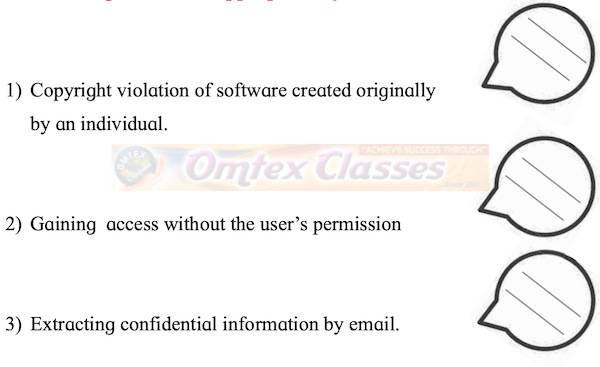Chapter 4: Cyber Law
Complete the following web.
SOLUTION
Left side (Do's)
Adhere to copyright restrictions when downloading material from the Internet, including software, games, movies, or music.
Report online bullying immediately to the teacher and parents/ or some one whom you trust.
Use a strong and unique password with combinations of numbers, uppercase and lowercase letter and special characters for each account(s) and change your password frequently.
Obtain software from trusted sources. Always scan files before opening them.
Check to see if the web address begins with https:// whenever you sign in online.
Connect only with known individuals.
Think twice before you post/like/ share something related to sensitive topics like politics, religion etc.
Report to the service provider immediately if the account is hacked. If possible deactivate your account.
Right side (Dont's)
Don't share your personal information: real name, date of birth, phone number etc. unnecessarily.
Don't send your pictures to unknown persons or share them on social media.
Don't open emails and attachments from strangers.
Don't respond to any suspicious email, instant message or web page asking for personal information.
Don't share your password/OTP with anyone.
Don't save your username and password on the browser.
Don't steal other's information.
Don't access or use files without the permission of the owner.
Don't copy software which has copyright without the author's permission.
Don't bully others online by teasing, threatening, using rude or offensive language, making derogatory or hateful comments.
Don't meet unknown (even if they are known only through online interaction) people alone; always inform an adult or a friend.
Don't open or download any attachments from an unknown source as they may be harmful.
Complete the following chart. Examples of unauthorized access
SOLUTION
Examples of unauthorized access
Hacking financial / bank account related information.
Stealing organizational / intellectual information.
Illegal monitoring of information owned by other users.
Illegal use/break of login and password of other users.
Causing intentional irritation to other users by means of damaging software and important information.
Fill following boxes with appropriate cyber crime name.
Copyright violation of software created originally by an individual.
SOLUTION
Software piracy
Gaining access without the user’s permission.
SOLUTION
Unauthorized Access
Extracting confidential information by email.
SOLUTION
Phishing
Read the following and answer the question.
Rahul lost his pen drive in his college computer lab. His classmate Madhav finds it .He carries it home to return it to him the next day. When Madhav opens it he finds his favourite game. He thinks of making a duplicate copy of the game software.
Does Madhav think ethically?
What do you think should Madhav do?
If he makes a duplicate copy then which cyber crime will he commit?
SOLUTION
No.
Madhav should returns back pen drive without making duplicate copy of game.
Software Piracy
What care should be taken by the user while doing online activities?
SOLUTION
Stick to copyright restrictions when downloading anything from the internet.
Use strong passwords with combinations of numbers. Uppercase and lowercase letters and special characters.
Always scan files before opining them.
Don’t talk to strangers
Think before posting something on social media related to any sensitive topic like politics, religion etc.
Report to service provider if the account is hacked; if possible deactivate your account.
Whenever you sign in online check if the web address begins with https: //
Define the term:
Ethics
SOLUTION
Also called moral philosophy is the discipline concerned with what is morally good and bad, right or wrong.
Moral
SOLUTION
The standards of behaviour; principles of right and wrong behaviour. Thus morals are dictated by society, culture or religion while ethics are chosen by the person himself which governs his life.
Explain three examples related to unauthorized access?
SOLUTION
Hacking financial / bank account related information.
Stealing organizational / intellectual information.
Illegal monitoring of information owned by other users.
Illegal use/break of login and password of other users.
Causing intentional irritation to other users by means of damaging software and important information.
Explain software piracy.
SOLUTION
Software piracy is the illegal copying, distribution, or use of software. It 15 such a profitable "business" that it has caught the attention of organized crime groups in a numb
Explain Hacking.
SOLUTION
Hacking refers to unauthorised intrusion into a computer or a network. Hacker is a person intensely interested in the deep and hidden or concealed working of any computer operating system and programming language. They might discover loopholes within systems and reasons for such loopholes.
Observe the following picture and give your opinion about it by responding to the following questions.
Is 'B's response correct or not?
What will be the consequences of 'B's reply?
Which type of cyber crime does the picture depict?
Solution
No B’s response is not correct.
With all such crucial information like OTP in hand, the fraudster can easily carry out illegal financial transactions using B’s identity.
Fake Call Frauds
Balbharati Solutions for Information Technology (IT) 11th Standard HSC Maharashtra State Board
The answers for the Balbharati books are the best study material for students. These Balbharati Solutions for Information Technology (IT) 11th Standard HSC Maharashtra State Board will help students understand the concepts better.
• Chapter 1: Basics of Information Technology
• Chapter 2: Introduction to DBMS
• Chapter 3: Impressive Web Designing
.



